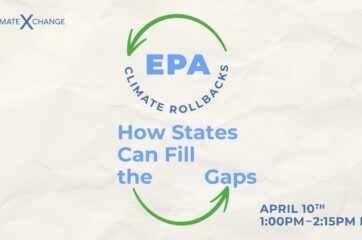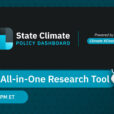With state legislative sessions in full swing and a barrage of new federal announcements affecting funding and policy decisions for states, it is critical for climate advocates and decision-makers to stay informed on the latest developments and opportunities. This includes understanding policy trends and high-impact policy opportunities across states and sectors. Join us to explore what policies are being introduced in state legislatures and what opportunities can create the greatest emissions reductions for states across the country.
We convened a panel of experts to dive into 2025 climate policy trends and opportunities for states. Our expert panel included Ava Gallo, Climate and Energy Program Manager at the National Caucus of Environmental Legislators; Ruby Wincele, Policy & Research Manager at Climate XChange; and Alicia Zhao, Research Manager at the Center for Global Sustainability at the University of Maryland.
In this recap article, we’ll provide highlights from our experts’ presentations, including climate trends in state legislation and regulation, as well as state-level policies to pursue in the absence of federal support.
Ava Gallo, National Caucus of Environmental Legislators
Ava Gallo serves as NCEL’s Climate and Energy Program Manager, where she works to support legislators across the country on every policy topic under the climate and clean energy umbrella. Ava received her undergraduate degree in Environmental Studies and International Affairs and her master’s degree in Security and Resilience Studies with a concentration in Resilient Cities, both from Northeastern University. Both her undergraduate and graduate theses have focused on the idea of community engagement within public climate projects.
Polluter Pays
“Polluter Pays” legislation aims to hold fossil fuel companies accountable for their impacts on communities by charging major emitters for climate-related damages and funneling that money into climate “superfund” accounts. With a recent gap in federal climate funding , states are utilizing this method to provide a sustainable source of funding for climate programs. Following Vermont and New York’s enacted climate superfund legislation in 2024, at least 10 states have introduced their own “polluter pays” bills in 2025:
- Superfunds for climate adaptation projects: Connecticut (H.B. 6280), Massachusetts (H. 1014), New Jersey (S 3545), and Oregon (SB 682)
- Superfunds for climate mitigation and adaptation projects: California (SB 684), Maryland (HB 128/SB 149), and Rhode Island (H 5424)
- Superfunds with an environmental justice investment requirement: California (SB 684), Connecticut (S.B. 1199), Hawaii (SB 1652), Massachusetts (H. 1014), Maryland (HB 128/SB 149), and Virginia (HB 2233)
Some states are also looking to bolster individuals’ ability to hold fossil fuel companies accountable by creating a “private right of action” for residents to sue polluters for their climate-related impacts:
- Private right of action: New York (S 4799), Oregon (SB 679), Hawaii (SB 1166), California (SB 222), and Illinois
Transmission
While much of our transmission grid is regulated at the federal level, states can work to meet rising energy demand, strengthen grid reliability, and bolster energy affordability through transmission modernization and expansion policy. Trending topics in state legislatures include promoting grid-enhancing technologies (GETs, also known as the energy efficiency of transmission) and advanced reconductoring, reforming siting and permitting processes, and creating transmission authorities:
- Advancing GETs: Rhode Island (HB 5573), Connecticut (H.B. 7206, H.B. 5230, and H.B. 7017), New York (S 2708 and S 5995), New Jersey (S 3464), Maryland (HB 1079, HB 1397, SB 483, SB 952, HB 659, HB 829, and HB 645), Virginia (HB 1822 and HB 2413), Indiana (SB 422), Illinois (HB 3779), Oklahoma (SB 610), New Mexico (HB 93), Colorado (SB 25-127), Utah (H.B. 212), Montana (SB 301), Oregon (HB 3336), and Washington (SB 5466, HB 1819, HB 1245, and HB 1673)
- Siting and permitting: New York (S 4066), Maryland (HB 645), Illinois (HB 3779), Rhode Island (H 5573), Colorado (HB 25-1292), and Washington (HB 1237 / SB 5246)
- Creating state-level transmission authorities, which is especially popular in the West where states don’t have a regional grid operator: Washington (HB 1673 / SB 5466), Oregon (HB 3628), and Montana (HB 314)
Other Electricity Policy Themes: Microgrids, Virtual Power Plants, and Data Centers
Microgrids and Virtual Power Plants (VPPs) are two emerging energy technologies that can promote grid resilience, energy independence, and renewable energy.
Amidst grid instability and high electricity prices, these mechanisms can provide a way to manage the grid we have and prepare for increasingly frequent extreme weather events. Legislation was recently introduced in New Hampshire, Massachusetts, Connecticut, New York, New Jersey, Maryland, Virginia, Illinois, Texas, New Mexico, Washington, Oregon, and California [see full list of bills here].
Data centers are also a hot topic across legislatures this year, with states just beginning to think about what relevant levers they can pull to address projected increased energy demand. Themes around data center regulation include:
- Ratepayer protections: ratepayers are on the hook for the grid upgrades required for data centers’ energy supply, while the companies deploying these data centers are benefitting from passing on those costs.
- Policy Highlight: GA SB 34 would mandate that any grid upgrade costs to accommodate data centers are recovered from those centers or prorated based on demand, rather than being passed on to ratepayers
- Transparency: information on how and when data centers use energy is not yet available, but is necessary for states to understand how they can better be incorporated into the grid.
- Demand side solutions: it’s important to explore energy efficiency measures for data centers and understand how we can dial up and dial down data centers as the grid peaks during different times of day.
- Clean energy requirements: more ambitious states are looking to require that data centers use clean energy to meet increased energy demand rather than keeping coal or natural gas plants online, or even building new natural gas plants.
DOT Reform
Reforming state-level Departments of Transportation (DOTs) to align with climate goals is another trend across some states, inspired by Colorado and Minnesota’s legislation enacted in 2021 and 2023, which require their DOTs to evaluate projects based on contributions to climate change and vehicle miles traveled (VMT). Multiple states, including Massachusetts (S.D. 1327), Illinois (SB 1680/HB 2629), Maryland (SB 395/HB 84), New York (S 4044/A 4230), and likely Maine, are introducing bills to set GHG and VMT caps for DOT projects and require mitigation efforts including investments in public transit, complete streets, and more.
Ruby Wincele, Climate XChange
Ruby Wincele is the Policy & Research Manager at Climate XChange, where she manages CXC’s State Climate Policy Dashboard and serves as CXC’s in-house policy tracker and expert on state climate policy landscapes. She also researches the economic, social, and environmental benefits of state climate policy, and provides pro bono technical assistance to policymakers and advocates working to pass equitable climate policy in their states. Prior to Climate XChange, Ruby worked at the MIT Environmental Solutions Initiative and Our Climate.
Community Solar
At least 40 bills across 17 states have been introduced this year related to community solar, building on the foundation of policies addressing shared renewables that 47 states have established so far:
- Establishing community solar pilots and programs: Georgia, Indiana, Iowa, Missouri, Montana, and West Virginia
- Expanding existing community solar programs by increasing program capacity, expanding customer eligibility, and more: California, Connecticut, Maryland, Minnesota, New Hampshire, New Jersey, New York, Oregon, Virginia, and Washington
Some states are working to ensure that community solar programs have specific incentives or requirements to serve low-income customers, including California’s AB 1260, Washington’s HB 1598/SB 5515 and New Jersey’s S 1392/A 4131.
Utility Reform
States across the country have started to address energy affordability and ratepayer protection through utility reform, with legislation enacted in 2023 by Colorado (SB 23-291), Connecticut (S.B. 7), and Maine (LD 325). Many bills were introduced in 2024, and at least 12 bills across eight states have been introduced in 2025:
- Prohibiting utilities from charging customers for political activities, trade association dues, and certain other expenses: Delaware (SB 60), Illinois (SB 1275), Indiana (SB 434), Maryland (HB 960), Massachusetts (H. 3400 / S. 2239), Oregon (SB 88), Rhode Island (H 5818, H 6005, S 593) and Utah (S.B. 153)
Environmental Justice Directives, Staffing, and Advisory Bodies
With the federal rescission of the Justice40 Initiative and recent EPA shutdown of all EJ offices, states are building out their capacity and staffing to address environmental justice (EJ) in climate policy and planning, with 20 states currently investing in EJ offices and staffers and 18 states with EJ advisory bodies. This year, at least 10 bills across eight states have been introduced that would establish new EJ offices, staff, and bodies, as well as incorporate EJ impacts into agency rules:
- Establishing new state EJ offices and staff: Texas (SB 561), Minnesota (HF 186 / SF 817), New Jersey (S 1392 / A 4131), Pennsylvania (SB 118)
- Expanding the responsibilities of existing EJ office: New Mexico (SB 4)
- Establishing new EJ advisory bodies: Texas (HB 859)
- Expanding or extending existing EJ advisory bodies: Colorado (SB 25-055) and Delaware (HCR 3)
Just Transition Plans, Offices, and Advisory Bodies
Investing in just transition planning and staffing is another key tool to support workers and communities impacted by the transition toward clean energy and away from fossil fuel production. These policies have been enacted in multiple states, with three states currently investing in just transition plans, six states with just transition offices and staff, seven states with just transition advisory bodies, and three states with just transition funds. This year, at least 24 bills in nine states have been introduced addressing these themes:
- Requiring the creation of state just transition plans: Connecticut (HB 5004), Florida (SB 1496 / HB 621), Illinois (SB 2269, HB 3525, HB 3650), Massachusetts (S. 2276, S. 2290, and H. 3547), and New York (S 5111)
- Requiring that gas utilities create just transition plans: Massachusetts (S. 2300, S. 2276, S. 2290, H. 3547, and H. 3523)
- Establishing just transition staffing, advisory bodies, and funding: Colorado (SB 25-181), Massachusetts (S. 2276, S. 2290, and H. 3547), New Mexico (SB 49), and New York (A 5147)
Other Trends: Decarbonizing Buildings, Transportation, Industry and More
States looking to advance building decarbonization are introducing legislation including:
- Requiring new construction to be all-electric
- Establishing Clean Heat Standards, especially in the Northeast and Midwest
- Establishing Building Performance Standards (BPSs) or increasing the types of buildings required to comply with existing BPSs
- Studying and piloting Thermal Energy Networks (TENs) and gas transition programs
- Ending gas pipeline subsidies and requirements that new customers must be connected to the gas system, and ending replacement requirements for aging gas infrastructure
Within the transportation sector, states are looking to establish a few key policies to reduce emissions:
- Establishing Low Carbon Fuel Standards
- Establishing VMT and/or GHG reduction targets for the transportation system
Electricity policies around renewable energy development and expansion are also common this year, revolving around a few key themes:
- Siting and permitting reform, including changing local vs. state control of permitting, expediting permitting approval (such as Massachusetts and New Jersey), aligning energy facility approval with climate goals (such as Rhode Island and Washington), and considering siting impacts to natural and working lands (such as Washington)
- Encouraging renewable energy development on brownfields, parking lots, mines, and landfills
Industry decarbonization is also extremely important, and states are especially looking to establish and strengthen methane regulations for oil and gas operations and landfills.
Other policy trends that cut across sectors:
- Aligning planning processes with climate and clean energy goals: including through utility planning, “future of gas” proceedings, and transportation system planning
- Prioritizing GHG reductions in EJ communities and considering cumulative impacts of new and existing facilities
Alicia Zhao, Center for Global Sustainability at University of Maryland
Alicia Zhao is a research manager at the Center for Global Sustainability, the University of Maryland. As CGS’s U.S. modeling lead, she uses quantitative analysis and energy systems modeling to understand national decarbonization pathways and the roles that subnational climate actors can play. Her work has contributed to the formulation of and discussion around U.S. climate targets. She holds a master’s degree in environmental management from Duke University, and a Bachelor’s degree in environmental science from Cornell University.
Modeling Non-Federal Policy Action in U.S. Climate Pathways
Since 2017, the Center for Global Sustainability (CGS) has worked to explore how states, cities, businesses, and other non-federal actions can play an important role in addressing climate change despite inaction from the federal government. In partnership with America is All In, a coalition of non-federal U.S. actors striving to achieve the Paris climate goals, CGS has utilized their open-source global Integrated Assessment Model with 50-state resolution to complete detailed modeling of concrete policy actions.
Most recently, they modeled how the U.S. can achieve a high-ambition 2035 climate target through an all-of-society policy approach, detailed in their report, Toward 2035: Forging a High-Ambition U.S. Climate Pathway (09/2024). After the November elections, they complemented this analysis by modeling increased ambition from subnational actors even with uncertainty in federal action, detailed in their report, U.S. Climate Pathways for 2035 with Strong Non-Federal Leadership (12/2024). These reports were developed utilizing lessons learned from 12 stakeholder engagement sessions across sectors and types of actors.
Current Policy Scenarios and Impacts on Emissions
CGS’s September 2024 analysis modeled all then-enacted policies at the federal and subnational levels, finding that they could achieve 48 percent emissions reductions by 2035. They also modeled an enhanced-ambition scenario, layering on new and expanded policies, which could achieve a 65 percent emissions reduction by 2035. In this enhanced-ambition scenario, the electricity and transport sectors had the largest potential for emissions reductions, although reductions are needed across all sectors.
After the November elections, CGS looked at what non-federal actors can do under potential federal rollbacks, finding that subnational policy action can counter much of the impacts. Their analysis found that subnational actions have the potential to achieve 54 to 62 percent emissions reductions by 2035, depending on the scale of the federal rollbacks — these reductions would be within the range of the 2035 U.S. Nationally Determined Contribution from the Paris agreement. If subnational actors do not step up, but simply maintain their existing actions, in the face of federal rollbacks, the U.S. would be on track for a 33 to 43 percent emissions reduction — showing plainly that states and other non-federal actors have an essential role to play in keeping us on track for the emissions reductions necessary to meet the Paris climate targets.
High-Impact State Climate Policy Opportunities
While the full extent of federal climate rollbacks is yet to be determined, there are clear high-impact policies that states can pursue across all sectors to keep us on track for our national 2035 emissions reduction goal, as assumed in the previous non-federal leadership scenario:
- Enhanced state-level renewable and clean electricity targets
- Widespread adoption of California’s EV sales targets
- Vehicle miles traveled reduction policies
- Oil and gas methane intensity standards
- Increased waste diversion efforts
- Building efficiency and electrification standards
- Industry carbon capture and sequestration targets
Challenges and Barriers to Implementing State Climate Policy Opportunities
Through CGS’s stakeholder engagement process, policy actors across spheres and sectors identified what barriers states may encounter in attempting to establish and implement the aforementioned policy actions. Overarching themes for these challenges include:
- Legal challenges for federal, state, and local policies
- Uncertainty around policy implementation and uptake
- Education and outreach around available tax credits and incentives
- Capacity constraints and lack of technical expertise in state agencies
- Feasibility and accountability (or lack thereof) in establishing climate and energy goals
- Regional cooperation between states, among states and local jurisdictions, and within interregional projects like transmission planning
- Cross-sectoral collaboration between states and non-governmental actors, such as among states, utilities, buildings, and automakers to ensure that EV infrastructure networks are connected
- Lack of state-led incentives: states can offer more “carrots” to encourage decarbonization such as through EV rebates, state-funded EV programs, manufacturing programs, and more
- Lack of state anticipatory investments: states should be more proactive in clean energy investments, which often take a long time to permit and build
Sector-specific Barriers
In addition to general challenges, stakeholders identified state policy opportunities to overcome sector-specific barriers, including:
- Streamlined permitting & siting processes
- Inadequate transmission and EV infrastructure across communities, especially related to multifamily housing and renters
- Reducing vehicle miles traveled, including through reimagined community design and planning that reduces reliance on personal vehicles
- Scaling new technologies, especially to become commercially available
- Split incentives, including when owners and developers of infrastructure are not incentivized to invest in energy efficiency or electrification, as the benefits are mostly seen by consumers (e.g. landlords not benefitting from installing EV charging equipment, while their renters do benefit)
State Climate Policy Pathways by Sector
CGS’s September report lays out pathways to achieve various policy goals across sectors, as relevant to state actions. In this presentation, they highlighted state actions related to electricity, transport, and methane, but the report dives into other sectors, all of which are needed in the face of federal rollbacks.
- Electricity: Ramping up clean energy & phasing out fossil fuels
- Investing in transmission, storage, and grid modernization
- Establishing and strengthening clean energy targets
- Exploring permitting reform
- Implementing carbon pricing
- Utilizing coal securitization
- Training and investing in the clean energy workforce
- Transport: Increasing EV adoption while reducing VMT
- Establishing EV sales targets
- Creating EV tax credits and rebate programs
- Investing in EV infrastructure, especially in communities with issues of accessibility
- Funneling federal funding for public transit or EV investments rather than traditional highway funding
- Expanding public transit programs
- Promoting micromobility, including e-bikes and scooter programs
- Methane: Increasing targeted abatement across sectors
- Setting oil and gas intensity standards
- Establishing leak detection and repair programs
- Banning routine flaring and venting
- Plugging orphan and idle wells
- Strengthening manure management practices
- Establishing zero-waste targets & landfill regulations
Q&A
Q: We talked a lot about the kind of opportunities and trends that would continue furthering climate ambition. Can anyone speak to any signs of retrenchment of climate policies, or GHG targets, or in general any kind of backwards movement for climate policy?
Ava Gallo: There is a lot of fear following the November elections looking at some of the outcomes, especially with affordability being such a big crisis right now. We’re really trying to highlight this story of in Washington state, their cap and invest program was on the ballot to be repealed, but it was defeated by a really high percentage, a higher percentage than any of the statewide office races, showing that there was this overwhelming majority of support for the program. That really shows when you have climate programs and you can communicate those benefits to the constituents in a way that impacts their real life, these programs are overwhelmingly powerful, so they are overwhelmingly popular. You can take something from the affordability crisis that we’re having right now and say, okay, we need to really demonstrate how climate programs and investing in clean energy is going to have a meaningful benefit on the average person’s life, and make it really tangible, so you can counteract that fear with with some positivity.
Q: In comparison to previous years, are you seeing an increased trend in anti-ESG bills at the local or state level?
Ruby Wincele: Off the top of my head, I cannot say if there is an increase compared to previous years, but it is a trend, and we all are also seeing the opposite trend, where states are also introducing pro-ESG and public divestment policies. Anti-ESG is getting a lot of attention, but there are states trying to counteract that and pass bills to require public disclosures and public divestment, ESG or not. Other examples include requiring companies to publicly report and disclose their emissions, and other things similar to that.
Ava Gallo: It is definitely a trend; I think it’s been a trend for a past couple of years. I just popped our Climate Finance Briefing Book in the chat for reference. It kind of gets at that, we are not necessarily highlighting the bills, but sort of the language that gets put in many anti-ESG bills. I think some of those bills can be masking and so really calling out that language that can be really helpful when saying no, this seems like it could be a good thing, but it’s certainly not.
Q: Alicia, on the emissions graph that you showed with different sectors, are emissions from the agriculture sector captured in that other bucket?
Alicia Zhao: Yes, we do capture agricultural emissions, and this is actually based on a previous report that we released, the all in America’s All In Climate Action on Lands. That portion of the graph was fed directly from the results from that model, which is a model that’s worked on previous agriculture emissions projections.
Q: Where does passenger rail fit into the Department of Transportation reform?
Ava Gallo: States have the ability to include any mitigation strategies they like in the legislation, and different states have taken different tactics. Passenger rail is a great candidate for mitigation!
Q: How many state public utility commissions or legislatures are working to fix the misplaced profit incentive for IOU shareholders that only make profit on CAPEX spend?
Ava Gallo: We’re tracking performance-based regulation in Maryland, Massachusetts, and Oregon so far — but not totally comprehensive! Our Utility Briefing Book has more information on best practice legislation from prior sessions.
Q: Are you seeing states working together on joint programs, investments, or policy initiatives (i.e., not just joint statements but implementation)? What opportunities are there for states to work in concert, especially when they are in geographic proximity to one another?
Ava Gallo: Yes absolutely — here are a few great examples of states working together: 21 states launched an initiative to deploy grid enhancing technology, 10 states hit an ambitious electric vehicle target, and New York signed a multi-state agreement to boost climate friendly heat pumps.
Q: Alicia, I’ve only been able to skim through the report and updated analysis quickly, but are you able to speak to any assumptions that were made in terms of building decarbonization policies, like BPS, and their ability to limit the need for future build out of the electricity grid?
Alicia Zhao: We model energy efficiency resource standards and zero-emission appliance and buildings policies. End-use sectors are linked to the electricity sector, so the additional efficiency or electrification definitely shows up on the grid. Here’s our technical appendix for reference.
* The views and opinions expressed by our guest speakers during the webinar and summarized in this article are their own and do not necessarily reflect the views or positions of Climate XChange.








